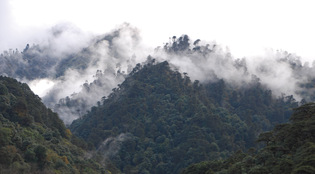 loading
loading
Nation of the forest Francine GardnerThe old-growth forest of the Black Mountains. View full imageA visitor’s first glimpse of the Bhutanese forest can be frightening. Spiky pine trees rush toward the jet as it banks to avoid the steep mountainsides and veers toward the country’s sole international airport. Its single runway is so perilous that only a handful of pilots are certified to land there. From the plane, the vista extends to snow-covered mountains rising more than 20,000 feet—the sharp young peaks of the Himalayas. We land in Paro, a town in a valley with thick forest beyond. Bhutan is known for the richness of life in its wilds. Clouded leopards and golden langur monkeys live in the subtropical foothills along the southern border with India; giant flying squirrels and red pandas inhabit temperate woodlands; black-necked cranes overwinter in the central valley; and blue sheep and rare snow leopards travel among the glaciated peaks that stretch northward toward Tibet. Bhutan has a fourth as many plant species as North America—a continent 600 times its size. And the city of Thimphu is most likely the only national capital where tigers roam within hiking distance. Seventy-two percent of the land in Bhutan is undeveloped forest. The extent of its forestland makes Bhutan exceptional. “All the hill stations that stretch along the arc of the Himalayas—Simla, Manali, Gangtok, Shillong, Itanagar, others—have undergone rapid, unsustainable change, to varying degrees,” says Jon Miceler ’01MEM, managing director for the eastern Himalayas program of the World Wildlife Fund. “As the surrounding countries of India and Nepal fragment their forests, dam their rivers, and undertake lots and lots of mining, wildlife—including elephants, tigers, snow leopards—will gravitate to Bhutan, because they have so much habitat intact. It’s increasingly going to be a refuge, a place for biodiversity, because its forests link up northeastern India to the east, and eastern Nepal and Sikkim to the west.” Conservation International calls the eastern Himalayas one of the world’s ten “biodiversity hotspots.” All ten together occupy only 1.4 percent of Earth’s surface. Miceler says the value of the forest to humans extends far beyond Bhutan; a large swath of South Asia depends on Bhutan’s intact forests. “The forest is a very important hydraulic regulator for north-south rivers that drain into India and Bangladesh. Natural forms of water storage are going to be very important as we potentially enter a drought cycle. These forests help regulate water that eventually empties into the Brahmaputra [River] and runs down to the Bay of Bengal.” And because of Buddhist and government prohibitions against hunting, says Miceler, “Bhutan is one of the few places you can go and see wild herds of rare ungulates”—hoofed animals such as goral and takin—“and feed wild monal pheasants around monasteries.” In their interactions with humans, “they have never known fear.” But can Bhutan remain a refuge? The pressures of urban life extend beyond flagpole cutting. Well-off Thimphu residents drive large SUVs. So do tour guides. More than 25,000 tourists visited last year, and the tourist industry hopes for 100,000 in 2012—in a country of just 700,000 people. The Bhutanese wear traditional dress at school and in the office, but on weekends, teenagers favor Western fashions like Converse knockoffs, skinny jeans, and flat-brim hip-hop hats. Monks carry cell phones in their robes. Furthermore, the nation is in the midst of a vast dam-building program, with all the associated environmental costs. Forty-five percent of its revenue now comes from electricity sales to neighboring India. Given that 23 percent of the Bhutanese population lives in poverty, Bhutan has good reason to seek economic growth. Its central preoccupation is how to do it right.
|
|